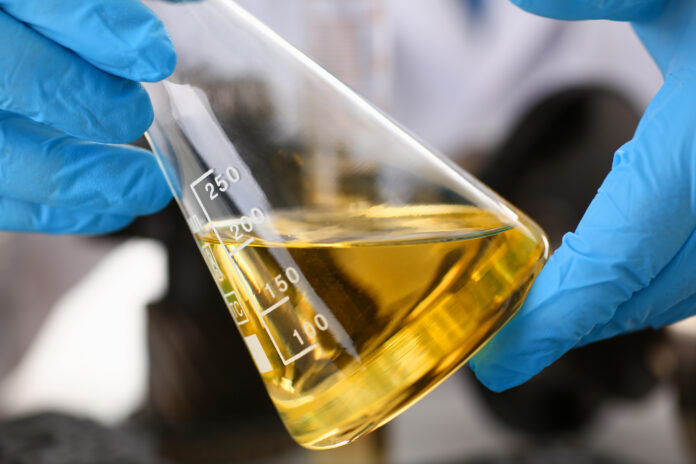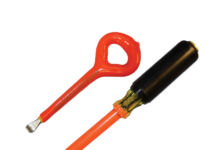Ever since companies began developing alternatives to traditional lubricants and greases, there has been some confusion surrounding the terms “environmentally friendly” and “food grade.” Just because a formulation meets the criteria for one doesn’t mean that it hits all the notes for the other, and vice versa. The Environmental Protection Agency (EPA) defines Environmentally Acceptable Lubricants (EAL) based on three criteria: biodegradability, toxicity to marine and aquatic life, and bioaccumulation. We’ll look at each of these in turn, as we dig deeper into finding the “secret sauce” that makes Renewable Lubricants’ Bio-Food Grade™ Hydraulic Fluids both environmentally friendly and food grade.
What Makes It Food Grade?
According to the National Sanitation Foundation (NSF), to be registered as a lubricant that allows for incidental food contact, the product must be odorless, colorless, and tasteless; must not contain more than 10 parts per million (ppm) of lubrication base oils (for example mineral oil), and it must be registered as H1 or certified to ISO 21469. Additionally, it must be manufactured from ingredients, chemical compounds, or additives allowed by the US FDA’s Code of Federal Regulations Title 21, Section 178.3570, or from ingredients which are “Generally Regarded as Safe (GRAS).
Bio-Food Grade™ Hydraulic Fluids are multi-functional, biosynthetic lubricants that contain ingredients which are classified as GRAS so they meet the criteria for food grade. They are safe for applications with incidental food contact in and around food processing equipment areas, including use on food processing equipment as a protective anti-rust film, as a release agent on gaskets or seals of tank closures, and as a lubricant for machine parts and equipment in locations in which there is a potential exposure of the lubricated part to food.
Feedstocks — The First Step
Feedstock plays a big part in determining whether a hydraulic fluid meets the EAL standard. Bio-based products, especially those made from vegetable oils, are inherently safer for the environment than petroleum-based products, which is just one reason for their increasing popularity. Formulations which use food grade edible oils along with vegetable-based oils that are further processed into a bio-synthetic to enhance their lubricity and protective properties are not only safer for the environment than petroleum-based products, but they are also safer for employees. Petroleum based products can be caustic and harmful if contacted on the skin, whereas bio-based products generally pose no problems with incidental skin contact.
Renewable Lubricants has developed a proprietary and patented technology using High Oleic Base Stocks (HOBS) which are agricultural biobased oils. Incorporating the super high viscosity index of the Stabilized™ HOBS into the formula increases the viscosity past synthetic levels (Energy Conserving Formulas). The super high viscosity index of the HOBS naturally improves the thermal shear stability of the formula and increases load capacity. The HOBS has an extremely low volatility that increases the flash and fires safety feature of the formular, making it safer for employees.
These patented biobased hydraulic fluids are formulated to perform in high- and low-pressure hydraulic systems that require Anti-Wear (AW), anti-rust, anti-oxidation, anti-foam, and demulsibility properties. They provide improved performance in oxidation stability over standard plant/vegetable/HETG and unsaturated HEES type fluids. Formulated to provide a longer seal life with reduced oil leakage, Bio-Food Grade™ Hydraulic Fluids meets or exceeds high-pressure pump requirements.
They are highly inhibited against moisture and rusting in both fresh and sea water, and pass A and B sequences of the ASTM D-665 Turbine Oil Rust Test. Formulated to provide a longer seal life with reduced oil leakage, this environmentally friendly, zinc-free product is ideal for vane, piston, and gear-type pumps and has shown excellent anti-wear performance in ASTM D-4172 Four Ball Wear Test. The anti-wear performance meets and exceeds requirements for Vickers M-2950-S (35VQ-25) and I-286-S (V-104C), Rexroth, US Steel 126, 136, and 127, and DIN51524 Part 2. They also meet the requirements for ashless GL-1 an GL-2 gear oils in reduction units and gear sets where EP gear oils are not recommended (use viscosity sufficient for OEM application).
To ensure performance and long life, Renewable Lubricants developed the stringent IsoGreen filtration standard which meets or exceeds the Rexroth pump guidelines for hydraulic fluids.
Biodegradable
Biodegradability is broken down into two classes – readily biodegradable and inherently biodegradable, based on how much of their product breaks down within a set timeframe. Readily biodegradable products break down by 60 percent or more within a 28-day period. If they do not meet this criterion, if for example they fall between 20 and 59 percent within the 28 days, then it is classified as inherently biodegradable. Most industrial applications strive for readily biodegradable products, but the classifications are not well understood or explained. Some products that are inherently biodegradable are merely marked “biodegradable” without explanation. When in doubt, ask for the details from the manufacturer or distribution channel partner before specifying a product based on its biodegradability. Bio-Food Grade™ Hydraulic Fluids are readily biodegradable.
Toxicity
The EPA and the US Fish and Wildlife Service base toxicity on how much of a chemical (with concentrations measured in parts per million) is present before it becomes harmful to plants (algae) and fish. There are different values for each. For acute toxicity for algae, EC50 in the concentration of test substance which results in a 50 percent reduction in either growth or growth rate relative to the control within 72 hours of exposure. The acute toxicity of fish is expressed as the median lethal concentration (LC50) is the concentration in water that kills 50 percent of a test batch of fish within 96 hours of continuous exposure. Bio-Food Grade™ Hydraulic Fluids exceed the acute toxicity levels (LC50/EC50 > 1000 ppm) adopted by the US Fish & Wildlife Service and the EPA.
With oxidation performance (biodegradability and toxicity) comparable to full synthetics, this is one of the safest hydraulic fluids for the environment and the only one that is food grade. In addition to use on food processing equipment, Bio-Food Grade™ hydraulic fluids are ideal for use in environmentally sensitive areas such as agriculture (especially in harvesting of grains destined for food products like tortillas, as well as working in and round fruit farms and processing facilities), marine environments, aboard fishing vessels, and more.
Bioaccumulation
Bioaccumulation is the buildup of foreign chemicals within the tissues of living organisms over time. Heavy metals like zinc, cadmium, and others either do not break down or do so very slowly. When they enter a water source, they are ingested by smaller fish. These are food sources for larger fish, which are food sources for larger fish, until the fish become food sources for humans.
Renewable Lubricants products are formulated with no zinc or other heavy metals, so there are no bioaccumulation worries. They are also free of VOCs, so they are safe for workers and the environment. Made from renewable agricultural biobased resources, they are not only safe for the environment and for use within food plants, but they are sustainable as well.













































